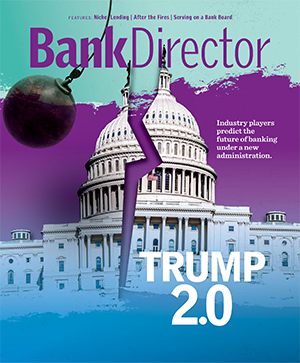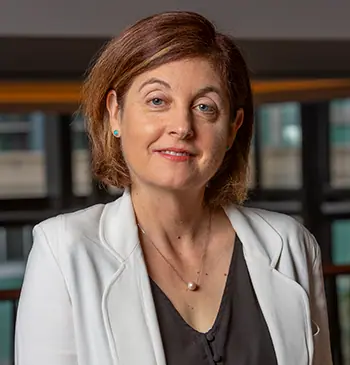Editor-in-Chief Naomi Snyder is in charge of the editorial coverage at Bank Director. She oversees the magazine and the editorial team’s efforts on the Bank Director website, newsletter and special projects. She has more than two decades of experience in business journalism and spent 15 years as a newspaper reporter. She has a master’s degree in journalism from the University of Illinois and a bachelor’s degree from the University of Michigan.

Capital One’s Secret to Success
As an undergraduate at the University of East London, Nigel Morris thought he might become a clinical psychologist someday. He was attracted to the work of Sigmund Freud and Carl Jung. But the more he studied psychology, he became increasingly bothered by his perception that people were “making stuff up.”
“I became a raving empiricist,” Morris says. “If I couldn’t measure it, it didn’t exist.”
That lead to an MBA at London Business School, and a trip to the United States that turned into a bank consulting job, where he met Richard Fairbank, who had recently graduated at the top of his class at Stanford University’s business school. The two young consultants shared an interest in empirical research. It was the late 1980s, and banks issued credit cards with the same rates and terms to pretty much everybody, ignoring the underlying risks of each customer. “You got 19% APR and a $20 annual fee, and any color you wanted as long as it was black,” Morris says. “It was the Henry Ford of banking.”
This perplexed them. Still both under the age of 40, Morris and Fairbank tried to sell the largest banks in the country on their concept of using data and information to lend and market to consumers. No one was interested. But after about 30 meetings with banks, their perseverance paid off. A small, nearly unknown lender in Richmond, Virginia, named Signet Bank, agreed to buy their concept, on the condition that they become employees of Signet Bank.
The two developed the foundation of the modern credit card business during the next six years, before the bank spun off the business in 1994 in an initial public offering that created Capital One Financial Corp., arguably one of the most successful and innovative companies of all time. But why and how has Capital One been able to achieve that? It appears that a strong culture and balance sheet, combined with the unique attributes of their founders, all played important roles.
Capital One, the seventh largest bank in the country according to Bank Director’s RankingBanking analysis, is a perennial top performer in the annual study sponsored by Crowe LLP and compiled by Piper Sandler & Co. It was No. 3 in its asset class of banks above $50 billion for the calendar year 2021. And it was No. 11 compared to all 300 of the largest publicly traded banks.
Over a longer period, Capital One has done incredibly well for shareholders. One key metric shows the kind of economic value Capital One has been able to create. Tangible book value growth plus dividends shows not how high the stock has risen, but how the company has managed to create value for shareholders while growing the tangible assets of the company. Capital One has managed a 272% growth in tangible book value plus dividends during the 10 years from 2011 to 2021, according to Kevin Barker, senior research analyst at Piper Sandler & Co.
To get a sense of just how well Capital One has grown, take a look at the tangible book value growth and dividends of other big banks over the 10-year period: The next closest commercial bank in terms of this metric is U.S. Bancorp, which returned 242%. JPMorgan Chase & Co. returned 189%, Wells Fargo & Co. 178% and Bank of America Corp. 100%.
Although competing credit card companies such as Discover Financial Services and Synchrony Financial Corp. also have bank charters and sometimes outperform Capital One on profitability metrics such as return on assets and return on equity, Capital One has managed the ups and downs of economic cycles in a unique way that others haven’t been able to match: low cost of funds, incredible asset quality and the higher yields of credit cards. (Discover and Synchrony aren’t included in Bank Director’s RankingBanking study, which uses S&P Global Market Intelligence’s data and definitions for banks; Discover and Synchrony are considered specialty lenders.)
Looking ahead, this year’s combination of inflation plus a possible recession threatens Capital One’s business, just as it threatens any other bank. Theoretically, Capital One should be more vulnerable than other banks. After all, Capital One grew to the size it is today in part catering to subprime consumers, usually not a successful demographic during a recession.
“[W]e worry a lot about inflation,” Fairbank said on Capital One’s first quarter 2022 earnings call, adding that inflation rising faster than wages is of particular concern for the bank’s customers. However, Capital One’s history offers a lot of evidence that its focus on data analytics, economic cycles and strong credit underwriting could make it well poised to weather another recession.
To understand Capital One today, it’s important to go back to its early history, where it moved ahead of what almost anyone else was doing in data analytics. Fairbank and Morris let customers choose their own terms so the company could see what motivated different groups of customers. Maybe one group preferred a lower monthly fee while another opted for rewards, for example. The bank looked at every customer key stroke on its website and used that data to improve the customer experience, says one former employee, now a senior executive at another big bank who asked that her name not be used since she couldn’t get permission from her current employer.
Capital One developed the concept of the balance transfer to help customers move money over to Capital One, says Morris. It invented the secure credit card, where customers with little to no credit could pay, for example, $1,000 as security in exchange for a $1,000 credit line and begin building a progressively larger line by paying on time.
Those early days could be exhilarating. Capital One recruited employees who were game for anything, digital experimenters. “Of course, we were making money hand over fist, but it was never about the money,” says the former employee. “It was about changing banking and making things better … It was glorious and motivating.” Early experiments weren’t always successful. In one case, the bank started a cell phone company in the ‘90s and then abandoned it. People moved from department to department, trying new things.
Another former employee, who also didn’t want to be named, says Capital One hired people who were “wicked smart; PhDs from the top universities in the U.S. and from Europe, advanced degrees from the top universities in China and India.” Getting smart people was only part of the equation. The other was building a culture where employees were empowered to do their best work. Former employees remember the culture as uniquely positive, one where management gave a lot of respect to employees. Sociopaths were not allowed.
Fairbank and Morris grew up without the internet, but they were leading the charge in creating a culture that was focused on digital transformation. Morris was known as the one with the charismatic personality, connecting with employees and remembering everyone’s name. Fairbank was more cerebral, the numbers guy. The two lead the company together for many years, until suddenly they didn’t. Morris left the company in 2004 because he wasn’t learning much anymore, he says. He went on to found QED Investors, which invests in fintech firms.
Capital One under Fairbank moved forward, buying a New Orleans-based bank named Hibernia in 2005 for about $5 billion. It was a brilliant move that allowed Capital One to get a stable low-cost deposit base to combine with its high-yield credit card business. It also diversified the asset side of its balance sheet, keeping a commercial real estate lending portfolio and growing to become one of the largest automobile lenders in the country. Another acquisition, of Long Island-based North Fork Bancorp in 2006, brought another banking franchise rich in deposits.
The financial crisis happened soon after. Capital One’s asset quality outpaced other big banks. Fairbank continued making acquisitions, including ING Direct, an early internet bank subsidiary of the Dutch ING Group, in 2012.
Fairbank kept his focus on operations, not on becoming a celebrity CEO. “The guy is absolutely brilliant,” says Richard Bove, the chief financial strategist at Odeon Capital Group, who has been following big banks as an equity analyst for decades. Fairbank is so well respected, even JPMorgan CEO Jamie Dimon stays late at investor conferences where they’re both speaking so he can hear Fairbank, hedge fund manager Tom Brown says.
“He’s a visionary,” Morris says, who got to know his partner commuting an average of 1 hour and 46 minutes each way to Richmond for work at Signet Bank. “He made me a much better problem solver and leader, and I owe him much.”
However, Fairbank can sometimes come off as evasive. “He’s got this very slow way, highly repetitious method of communicating,” Bove says. On the first quarter 2022 earnings call, Fairbank used the word “journey” 18 times. “Fairbank always talks about how they use technology, how important technology is, how it’s a new era, why there’s a paradigm shift, but he never tells you exactly what he is doing,” Bove says. In the early days, Fairbank talked to the media and to analysts such as Bove. Now, he’s rarely quoted anywhere, except in official business such as quarterly earnings calls. “It’s been that way for at least a decade,” says Brown. “Most companies talk too much.” Brown explains that competitors are interested in what Fairbank has to say. Fairbank knows that, leading him to be extra cautious about the sort of details he reveals. The media relations department didn’t respond to repeated requests for comment for this article. Attempts to reach employees or even business partners were rebuffed, citing the company’s reticence to engage with the media.
Part of that reticence may be justified. In the early days, Capital One was doing something no one else was. But its edge in terms of data analytics and technological prowess has eroded as other banks and lenders have adopted similar strategies. These days, Fairbank says the market for tech talent is the toughest he’s ever seen.
About eight years ago, Capital One was one of the first to begin moving substantial amounts of its transactions to the cloud when other banks still balked at the concept. It rushed to hire software engineers and embraced digital transformation over a decade ago. “I think they were more forward-looking in going to the cloud … and have been talking about this digital transformation for about 10 years now,” says Piper Sandler’s Barker. “So, I think they’re more aggressive or more willing to embrace technological changes than a lot of other banks.”
Also, Capital One was branch-light before other banks began cutting their branches. They introduced the concept of bank cafés in cities such as Atlanta, Philadelphia, Detroit and Chicago, where people can stop in for coffee, use the internet and find out about banking services. “[Fairbank] never got bogged down with high-cost delivery systems to get to the customer,” says Bove.
Capital One also developed a reputation for being willing to bank the subprime credit card market — something other banks weren’t willing to do. But serving those customers without destroying the bank required careful attention to underwriting, economic cycles and data. If you’re good at consumer credit, you can have outsized returns, says one former executive, who asked not to be named. If you’re bad at it, you can blow up the bank. “Capital One is one of the best risk managers in the banking industry,” Bove says.
Sanjay Sakhrani, an equity analyst and managing director at the investment bank Keefe, Bruyette & Woods, says the bank focuses its efforts on the most profitable risk-adjusted return segments. “I think they’ve done a very effective job [of] underwriting and managing risks inside of the subprime population,” he says. The bank starts by offering those customers low credit lines and graduates them over time as they demonstrate their credit worthiness.
The bank also is nimble, pulling in and out of different credit markets when necessary. In recent years, for example, Capital One has pulled back on subprime credit and ramped up its portfolio of high-spend, high-income customers. It also has moved upmarket to automobile buyers with better credit, according to Sakhrani. “I think a big part of what drives the superior ROA is that they’ve focused on what they deem is the most profitable asset class, as many of their peers are more broad-based in terms of asset categories,” Sakhrani says.
The bank’s focus on data extends to marketing. Capital One knows when to move in with heavy marketing and product offers, and when to pull back. “I’ve always been amazed at their ability to do that, their ability to dive into the market if the time is right to do it,” Bove says.
Fairbank is fond of saying the bank zigged while others zagged. During the bank’s first quarter earnings call this year, he said the bank looks at trends impacting the financial health of consumers, of course, but also spends a lot of time looking at what its competitors are doing. When credit card companies appear to be saturating the market with expensive rewards, Capital One reacts. “You have to be willing to operate the company on this horizontal approach and back off from the segments that everybody likes because everybody likes them, and they’re going after them,” Brown says. “Then, they go forward when perhaps the time doesn’t look so good.”
Capital One’s marketing spend reflects that. While other banks keep their marketing budgets consistent year after year, with slight variations, Capital One cut its spending about one-third in 2020 as the pandemic gripped the world. The following year, in 2021, Capital One lurched forward with a nearly 80% increase in marketing spend, taking its advertising slogan “What’s in Your Wallet?” to a new level. And Capital One spends a lot of money on marketing. A lot. It spent $2.87 billion last year, or 95% of what JPMorgan Chase spent, despite being about 12% of JPMorgan’s asset size.
The executive team focuses on long-term results rather than quarterly results, and that sometimes makes short-term investors unhappy. “The thought process is different at Capital One than it is at most companies,” Brown says. Capital One looks at customer value in terms of long-term vintages, not how customers perform over a quarter, he says. Sometimes, it looks like Capital One is spending too much money when everyone is cutting back.
Capital One isn’t a follower, by any means. It takes the road less traveled. Staying focused on what it knows best — credit, data and a superior culture — helped Capital One’s performance over time. “People call me up and say, ‘My daughter is thinking about going to Capital One, Nigel, what do you say?’” Morris says. His answer: “If you’re going to work for a bank, there’s probably not a better one on the planet. It’s got a great culture. It is well run. And it cares about assembling and fostering talent like no other bank on the planet.”
And that has made all the difference.
Naomi Snyder is editor-in-chief of Bank Director.


